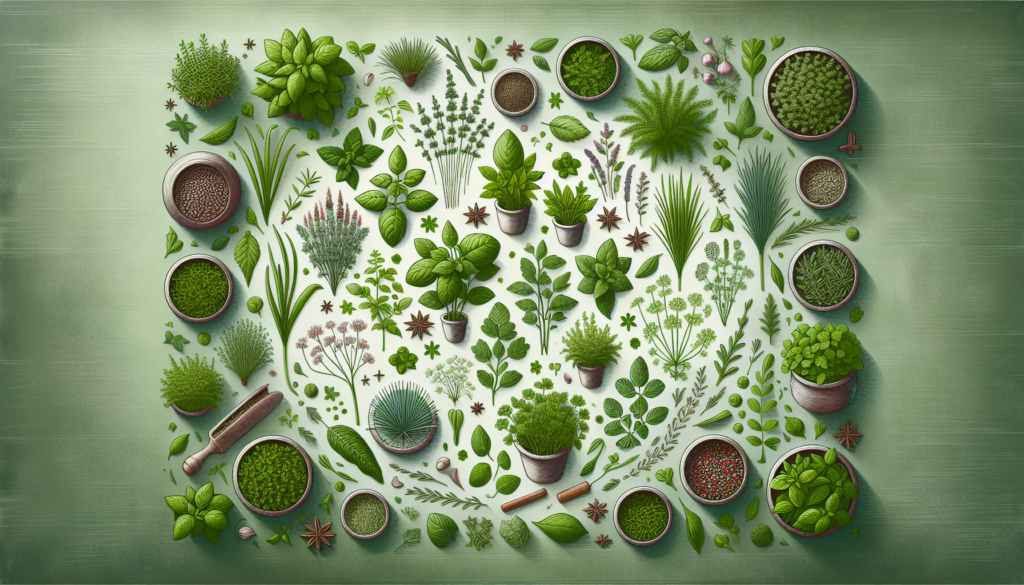So you’ve decided to embark on your culinary journey and grow your own herb garden. A brilliant idea! However, before you start planting your favorite herbs side by side, there’s one crucial thing you should know: not all herbs make good neighbors. Just like us, some herbs have a harmonious relationship, while others clash and can’t stand each other. From mint and parsley to rosemary and basil, discover in this article the herbs that cannot go together, ensuring a thriving and harmonious herb garden that will elevate your dishes to a whole new level.
Basil
Basil is a popular herb that is widely used in various cuisines around the world. It has a sweet and slightly peppery flavor that adds depth and complexity to dishes. When it comes to pairing basil with other herbs, there are a few combinations that work particularly well.
1.1. Sage
Sage and basil are a delicious herb pairing that can elevate the flavor of your dishes. Sage has a slightly earthy and savory taste that complements the sweet and peppery notes of basil. This combination works particularly well in pasta dishes, soups, and roasted meats.
1.2. Thyme
Thyme is another herb that pairs beautifully with basil. Thyme has a slightly floral and earthy flavor that complements the sweetness of basil. This combination is often used in Mediterranean dishes, such as roasted vegetables, grilled fish, and tomato-based sauces.
1.3. Rosemary
Rosemary is a robust herb with a strong flavor that pairs well with the delicate taste of basil. The woody and pine-like taste of rosemary adds a wonderful depth to dishes when combined with basil. This combination is often used in meat marinades, roasted potatoes, and hearty stews.
2. Oregano
Oregano is a versatile herb that is commonly used in Italian and Mediterranean cuisine. It has a bold and slightly bitter flavor that adds a delicious kick to dishes. When it comes to pairing oregano with other herbs, there are a few combinations that work exceptionally well.
2.1. Mint
Mint and oregano are a refreshing herb combination that can brighten up your dishes. Mint has a cool and slightly sweet taste that pairs perfectly with the bold and bitter flavor of oregano. This combination is often used in salads, cocktails, and desserts.
2.2. Parsley
Parsley is an herb that complements oregano beautifully. Parsley has a fresh and slightly peppery flavor that balances out the bitterness of oregano. This combination is often used in Mediterranean dishes, such as tabbouleh, grilled vegetables, and seafood.
2.3. Cilantro
Cilantro and oregano create a unique and flavorful herb pairing. Cilantro has a bright and citrusy taste that pairs well with the bold flavor of oregano. This combination is often used in Mexican and Latin American dishes, such as salsas, guacamole, and tacos.
[table id=2 /]

3. Sage
Sage is an aromatic herb with a strong and earthy flavor. It adds a distinct taste to dishes and is often used in stuffing, roasted meats, and savory sauces. When it comes to pairing sage with other herbs, there are a few combinations that work particularly well.
3.1. Basil
Sage and basil create a flavorful herb combination that can enhance the taste of your dishes. The sweet and peppery flavor of basil complements the earthiness of sage, creating a harmonious blend of flavors. This combination is often used in pasta dishes, roasted vegetables, and soups.
3.2. Rosemary
Rosemary and sage are a classic herb pairing that adds depth and richness to dishes. Both herbs have strong flavors that work well together, creating a robust and aromatic taste. This combination is often used in roasted meats, potatoes, and bread.
3.3. Tarragon
Tarragon and sage create a unique and vibrant herb combination. Tarragon has a slight anise-like taste that pairs well with the earthiness of sage. This combination is often used in French cuisine, such as sauces, vinaigrettes, and roasted chicken.
4. Thyme
Thyme is a versatile herb with a slightly floral and earthy flavor. It adds a wonderful depth of flavor to dishes and is often used in soups, stews, and marinades. When it comes to pairing thyme with other herbs, there are a few combinations that work exceptionally well.
4.1. Basil
Thyme and basil create a delicious herb combination that can enhance the taste of your dishes. The floral and earthy flavor of thyme complements the sweet and peppery notes of basil, creating a well-rounded and aromatic taste. This combination is often used in pasta dishes, roasted vegetables, and grilled meats.
4.2. Parsley
Parsley is an herb that pairs beautifully with thyme. The fresh and slightly peppery flavor of parsley balances out the floral and earthy taste of thyme, creating a harmonious blend of flavors. This combination is often used in Mediterranean dishes, such as salads, soups, and roasted vegetables.
4.3. Rosemary
Rosemary and thyme are a classic herb pairing that adds complexity and richness to dishes. Both herbs have robust flavors that complement each other, creating a fragrant and aromatic taste. This combination is often used in roasted meats, potatoes, and bread.

5. Rosemary
Rosemary is a strong and aromatic herb that adds a delightful flavor to dishes. It has a woody and pine-like taste that works well in savory dishes. When it comes to pairing rosemary with other herbs, there are a few combinations that work particularly well.
5.1. Sage
Rosemary and sage create a flavorful herb combination that can elevate the taste of your dishes. The earthy and savory flavor of sage complements the woody taste of rosemary, creating a robust and aromatic blend. This combination is often used in roasted meats, potatoes, and stuffing.
5.2. Thyme
Thyme and rosemary are a classic herb pairing that adds depth and complexity to dishes. Both herbs have aromatic flavors that work well together, creating a fragrant and flavorful taste. This combination is often used in roasted vegetables, grilled meats, and marinades.
5.3. Cilantro
Cilantro and rosemary create a unique and unexpected herb combination. Cilantro has a bright and citrusy taste that pairs well with the woody flavor of rosemary, creating a delicious contrast of flavors. This combination is often used in marinades, salsas, and roasted vegetables.
6. Mint
Mint is a refreshing herb with a cool and slightly sweet taste. It adds a burst of freshness to dishes and is often used in salads, cocktails, and desserts. When it comes to pairing mint with other herbs, there are a few combinations that work exceptionally well.
6.1. Oregano
Mint and oregano create a refreshing herb combination that can brighten up the taste of your dishes. The cool and sweet flavor of mint complements the bold and slightly bitter taste of oregano, creating a vibrant and flavorful blend. This combination is often used in salads, grilled meats, and Mediterranean dishes.
6.2. Parsley
Parsley is an herb that pairs beautifully with mint. The fresh and slightly peppery flavor of parsley balances out the coolness of mint, creating a well-rounded and aromatic taste. This combination is often used in salads, tabbouleh, and seafood dishes.
6.3. Cilantro
Cilantro and mint create a unique and herbaceous combination. The bright and citrusy taste of cilantro pairs well with the cool and refreshing flavor of mint, creating a delicious and vibrant blend. This combination is often used in Mexican and Asian cuisines, such as salsas, curries, and salads.
7. Parsley
Parsley is a versatile herb with a fresh and slightly peppery flavor. It adds a bright and aromatic taste to dishes and is often used in salads, soups, and sauces. When it comes to pairing parsley with other herbs, there are a few combinations that work particularly well.
7.1. Oregano
Parsley and oregano create a flavorful herb combination that can enhance the taste of your dishes. The fresh and peppery flavor of parsley complements the bold and slightly bitter taste of oregano, creating a well-balanced and aromatic blend. This combination is often used in Mediterranean dishes, such as pasta sauces, grilled meats, and roasted vegetables.
7.2. Thyme
Thyme is an herb that pairs beautifully with parsley. The floral and earthy flavor of thyme adds depth to the fresh and peppery taste of parsley, creating a harmonious and fragrant blend. This combination is often used in soups, stews, and roasted meats.
7.3. Mint
Mint and parsley create a refreshing herb combination that can brighten up your dishes. The cool and slightly sweet flavor of mint complements the fresh and peppery taste of parsley, creating a vibrant and aromatic blend. This combination is often used in salads, drinks, and desserts.
8. Cilantro
Cilantro is a flavorful herb with a bright and citrusy taste. It adds a burst of freshness to dishes and is often used in Mexican, Asian, and Middle Eastern cuisines. When it comes to pairing cilantro with other herbs, there are a few combinations that work exceptionally well.
8.1. Oregano
Cilantro and oregano create a unique and flavorful herb combination. The bright and citrusy taste of cilantro pairs well with the bold and slightly bitter flavor of oregano, creating a delicious and aromatic blend. This combination is often used in salsas, guacamole, and Mexican-inspired dishes.
8.2. Rosemary
Rosemary and cilantro create an unexpected herb pairing that adds complexity to dishes. The woody and pine-like taste of rosemary complements the bright and citrusy flavor of cilantro, creating a delicious contrast of flavors. This combination is often used in marinades, rice dishes, and roasted vegetables.
8.3. Mint
Mint and cilantro create a refreshing and herbaceous combination. The cool and slightly sweet taste of mint pairs well with the bright and citrusy flavor of cilantro, creating a vibrant and flavorful blend. This combination is often used in salads, curries, and drinks.
9. Tarragon
Tarragon is an herb with a slight anise-like taste that adds a unique flavor to dishes. It is often used in French cuisine, particularly in sauces, vinaigrettes, and roasted poultry. When it comes to pairing tarragon with other herbs, there are a few combinations that work particularly well.
9.1. Sage
Tarragon and sage create a flavorful herb combination that can enhance the taste of your dishes. The earthy and savory flavor of sage complements the slight anise-like taste of tarragon, creating a well-balanced and aromatic blend. This combination is often used in stuffing, roasted meats, and rich sauces.
9.2. Basil
Basil is an herb that pairs beautifully with tarragon. The sweet and peppery flavor of basil balances out the slight anise-like taste of tarragon, creating a delicious and aromatic blend. This combination is often used in Italian dishes, such as pasta sauces, pizzas, and tomato-based dishes.
10. Dill
Dill is a herb with a fresh and slightly tangy taste that adds a burst of flavor to dishes. It is often used in pickling, seafood dishes, and creamy sauces. When it comes to pairing dill with other herbs, there are a few combinations that work exceptionally well.
10.1. Fennel
Dill and fennel create a flavorful herb combination that can elevate the taste of your dishes. The fresh and tangy flavor of dill complements the slightly sweet and anise-like taste of fennel, creating a well-rounded and aromatic blend. This combination is often used in salads, soups, and roasted vegetables.
10.2. Lavender
Lavender and dill create an unexpected herb pairing that adds a unique and floral flavor to dishes. The fragrant and slightly sweet taste of lavender complements the fresh and tangy flavor of dill, creating a delightful contrast of flavors. This combination is often used in desserts, such as cakes, cookies, and infused syrups.
10.3. Cilantro
Cilantro and dill create a vibrant and herbaceous combination. The bright and citrusy taste of cilantro pairs well with the fresh and tangy flavor of dill, creating a delicious and aromatic blend. This combination is often used in salads, salsas, and Mediterranean-inspired dishes.
In conclusion, the world of herbs offers a wide range of flavors and aromas that can enhance the taste of your dishes. While there are certain herbs that do not pair well together, such as basil and cilantro, there are many other combinations that work beautifully. By understanding the flavor profiles of different herbs and experimenting with various pairings, you can create delicious and well-balanced dishes that will impress your taste buds. So, go ahead and explore the wonderful world of herbs to add a touch of freshness and sophistication to your culinary creations!

